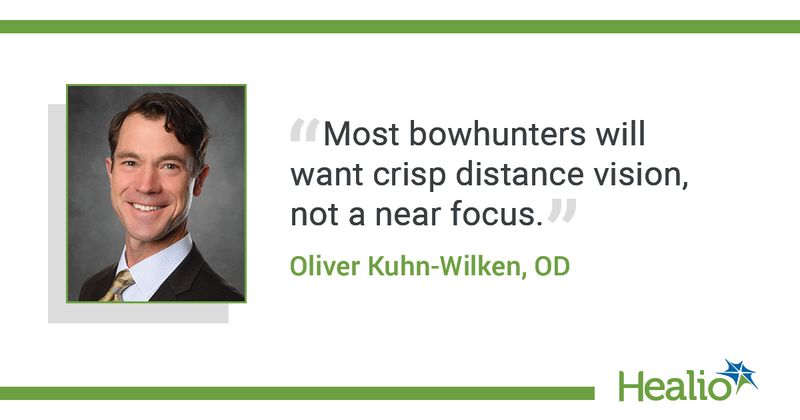BLOG: How to guide a bowhunter through cataract surgery
Last fall, we discussed unique issues that face firearm hunters when they’re considering their best refractive target after cataract surgery. Today, we’ll cover a related topic: How to counsel a bowhunter about their ideal refractive target.
The most important issue for bowhunters is whether they would like their targeting eye to be focused on the target (bullseye or animal), or on the targeting system of the bow. Although the majority of bowhunters will want crisp distance vision, some bowhunters use a strategy of focusing on the targeting system of the bow and letting the target itself remain slightly blurry.

Modern bows are most often targeted using a rear “peep sight” and a front sight mounted on the body of the bow. The peep sight is a tiny sight mounted on the rear string of the bow, through which the hunter looks; their eye is about an inch from this sight. The peep is small enough to provide a vignetting effect, which is to say that it reduces the scene’s brightness towards the periphery but is too large to provide any pinhole effect. The front sight is a large ring, usually with five “pins” within it — horizontal indicators for targeting depending on the distance to the target. These are often lit using fiber optics.
Some, but not all, archers are accustomed to prioritizing this front sight when targeting. If you have a conversation with your patient and this is the case, you will want to ensure both of you understand the strategy for keeping that front sight in focus after cataract surgery.
There are three ways to do this: The first is to target a very slight myopia in their targeting eye. This will necessitate measuring the distance from your bowhunter’s targeting eye to that front sight, then calculating the ideal focal point for that eye such that its depth of focus encompasses the sight.
Remember that the aiming eye does not need to be focused precisely at the plane of the sight, only to have a depth of field that includes that sight. Because depth of field is dependent on many complex factors, including the ambient light level, it can be difficult to determine. For a hunter who is interested in vision at daybreak and dusk, when pupils are larger, the depth of field will generally be 0.50 D to 0.75 D (Sergienko NM, et al).
For example, if they measure 30 inches to their front sight, that equals a dioptric demand of about 1.25 D. For a hunter with a 0.75 D depth of field, if the surgery center targeted –0.87 D, the near half of their depth of field would encompass the sight (1.25 D – 0.375 D = 0.87 D). Often using contact lenses to trial a 0.50 D or 0.75 D myopia, especially if this can be done in low light to simulate dusk or dawn, is the best way to arrive at an accurate target.
Some presbyopic bowhunters are already confronting this issue and use a + 0.50 D or + 0.75 D pair of shooting glasses or contact lenses.
A second strategy for targeting after cataract surgery would be to utilize a focusing lens within the rear peep sight. Several companies make lenses to fit in this peep sight, allowing presbyopes to focus on the front sight. Not all bowhunters will be fans of this device.
A third strategy is simply to understand that glasses may be the most flexible way to accommodate all of a hunter’s needs.
Resorting to low-dose brimonidine or other miotic drops will not generally be welcome, as bowhunters prize good vision during the low-light conditions of dusk and dawn.
Remember that most bowhunters will want crisp distance vision, not a near focus. The strategies discussed above are only appropriate for those who want their bow’s targeting system, not the target, to be in focus.
Reference:
- Sergienko NM, et al. Graefes Arch Clin Exp Ophthalmol. 2008;doi:10.1007/s00417-008-0923-3.
For more information:
Oliver Kuhn-Wilken, OD, practices at Pacific Cataract and Laser Institute’s Tualatin Clinic in Oregon. He can be reached at Oliver.Wilken@pcli.com.
Collapse
